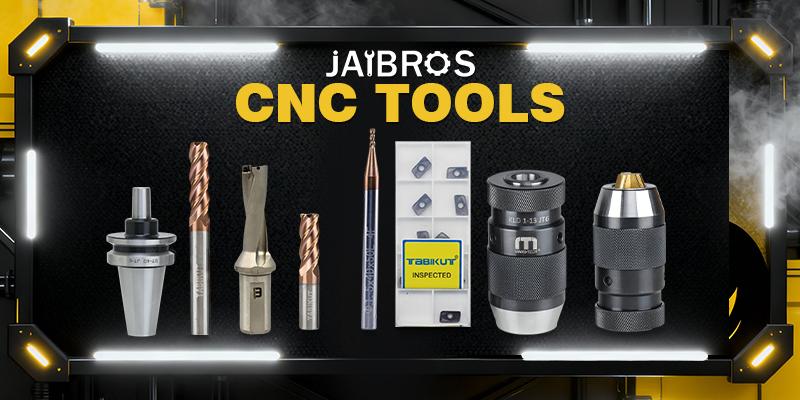CNC Tools Care Guide: Improve Tool Life & Performance

How to Extend Tool Life: Expert Tips for CNC Tools Maintenance
In today's manufacturing, the accuracy, speed, and productivity of operations are largely based on the maintenance of your CNC tools. A highly advanced machine is still worthless if the tooling is not maintained well. Tool maintenance is, however, much more than cleanliness. Tool maintenance also means greater performance, less wear, and consistent output during machining. The longer the tools last, the more efficient machining activities." The efficiency of any tool you purchase, either from a CNC tools online shop or local dealer, depends on how well you maintain it in your daily operations.
Why Tool Life Matters in CNC Machining
CNC machining relies on precision. If the tool becomes dull, worn out, or improperly calibrated, even the smallest defect can lead to:
-
Poor surface finish
-
Increased tool vibration
-
Higher scrap rates
-
Excessive machine load
Using the best CNC tools is only effective when paired with proper handling and maintenance. Tool care helps prevent sudden tool failure and minimizes downtime, leading to smooth production flow.
Tip 1: Use the Appropriate Tool for the Appropriate Material
Not all materials can be machined using the same type of CNC tools. The base material of the tool and coating, if present, needs to be compatible with the hardness of the material you are cutting. Softer materials, such as aluminum, typically cut fine with the use of HSS or coated carbide tools because the tool will cut without creating excessive heat. Tougher materials, like stainless steel or cast iron are better with tools that are made from solid carbide or coated carbides due to their ability to withstand the heat and maintain their cutting edge. Also, plastics and acrylics require sharp HSS tools to reduce melting or rough edges. Properly selecting the tool material based on the type of workpiece material will provide increased tool life and improve the finish.
Tip 2: Optimize Feed Rate and Cutting Speed
Tool wear is directly related to speed and feed settings. If the speed is too high, the tool may overheat. Too slow, and the tool will rub instead of cutting. Follow these rules:
-
Never start machining at full speed—test gradually.
-
Use manufacturer-recommended speed settings.
-
Maintain a balance between tool pressure and speed.
Remember, even the best CNC tools will wear out faster if the RPM and feed rates are incorrect.
Tip 3: Use Proper Coolant and Lubrication
Heat is the biggest enemy of tool life.
Using coolant helps:
-
Maintain temperature stability
-
Improve chip evacuation
-
Prevent cracks and tool burning
Coolant ensures smooth tool movement while reducing friction between the material and cnc tools. Regularly check coolant pressure and filtration to avoid contamination.
Tip 4: Inspect Tools Regularly for Wear
Before starting or switching operations:
-
Look for micro-cracks
-
Check cutting edges for dullness
-
Examine chips during machining—discolored chips indicate overheating
This prevents tool breakage and reduces scrap. Frequent inspection also improves tool usage planning and replacement timing. Many professionals often consult CNC tooling suppliers to understand different wear patterns and select better tools.
Tip 5: Store Tools Properly
Tool storage plays a huge role in tool life. Never throw tools into a drawer without protection. A small impact can ruin sharp edges.
Good practices include:
-
Using protective toolboxes or sleeves
-
Keeping tools away from moisture
-
Labeling tools according to size and material compatibility
Premium manufacturers and every reliable CNC tool online shop also recommend following proper storage protocols to maintain tool quality.
Tip 6: Use Chip Control Techniques
Uncontrolled chip formation can cause heat buildup and reduce tool performance. Use the correct tool geometry and cutting angle to get smoother chip evacuation. This stops chips from sticking to the tool and prevents premature dulling.
Tip 7: Keep Your Machine Well-Calibrated
Even the best tool won’t perform correctly if your CNC machine isn’t calibrated.
Machine calibration includes:
-
Checking spindle alignment
-
Balancing tool holders
-
Ensuring no vibration during cutting
A machine in good condition reduces pressure on the CNC tools and extends their life.
Conclusion
Maintaining your CNC tools is essential for achieving the best performance, improving tool longevity, and reducing operational costs. By selecting the right tool, optimizing feed and speed, using coolant, inspecting regularly, and storing properly, you can significantly extend tool life. High-performance machining depends not just on the tool itself, but on how it's used, handled, and maintained. Long-lasting tools mean smoother production, fewer breakdowns, and increased profitability.
About Jaibros
If you’re looking for top-quality machining tools, Jaibros.com is a trusted industrial tooling store offering a wide range of CNC accessories and machine tools. Their collection is suitable for CNC machining, manufacturing units, and engineering workshops.
FAQs
1. How can I increase the lifespan of CNC tools?
Use the correct feed rate, maintain proper lubrication/coolant, and inspect tools regularly for wear.
2. Does material type affect tool wear?
Yes. Hard materials such as stainless steel increase tool wear faster than aluminum or plastics.
3. Why is coolant important during machining?
Coolant reduces heat, prevents tool burning, and increases tool life.
4. How often should I inspect CNC tools?
Inspect tools before every job change or shift—regular inspection avoids sudden tool failure.
5. What are signs that a CNC tool needs replacement?
Poor finish quality, unusual vibration, discoloration of chips, or visible wear on cutting edges.





